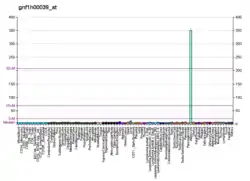THRSP
Thyroid hormone-inducible hepatic protein is a protein that in humans is encoded by the THRSP gene.[4][5]
| THRSP | |||||||||||||||||||||||||
|---|---|---|---|---|---|---|---|---|---|---|---|---|---|---|---|---|---|---|---|---|---|---|---|---|---|
| Identifiers | |||||||||||||||||||||||||
| Aliases | THRSP, LPGP1, Lpgp, S14, SPOT14, THRP, thyroid hormone responsive | ||||||||||||||||||||||||
| External IDs | OMIM: 601926 MGI: 109126 HomoloGene: 2441 GeneCards: THRSP | ||||||||||||||||||||||||
| |||||||||||||||||||||||||
| |||||||||||||||||||||||||
| |||||||||||||||||||||||||
| Orthologs | |||||||||||||||||||||||||
| Species | Human | Mouse | |||||||||||||||||||||||
| Entrez | |||||||||||||||||||||||||
| Ensembl | |||||||||||||||||||||||||
| UniProt | |||||||||||||||||||||||||
| RefSeq (mRNA) | |||||||||||||||||||||||||
| RefSeq (protein) | |||||||||||||||||||||||||
| Location (UCSC) | Chr 11: 78.06 – 78.07 Mb | n/a | |||||||||||||||||||||||
| PubMed search | [2] | [3] | |||||||||||||||||||||||
| Wikidata | |||||||||||||||||||||||||
| |||||||||||||||||||||||||
The protein encoded by this gene is similar to the gene product of S14, a rat gene whose expression is limited to liver and adipose tissue and is controlled by nutritional and hormonal factors.
This gene has been shown to be expressed in liver and adipocytes, particularly in lipomatous modules. It is also found to be expressed in lipogenic breast cancers, which suggests a role in controlling tumor lipid metabolism.[5]
Previously, THRSP was among the identified upregulated genes in the prefrontal cortex of spontaneously hypertensive rats (SHR/NCrl) and Wistar-Kyoto (WKY/NCrl) rats which exhibited inattention behavior.[6] Subsequently, overexpression of THRSP induced inattention, but not hyperactive and impulsive behavior in mice, suggesting that this gene plays a role in the inattention phenotype of ADHD.[7]
References
- GRCh38: Ensembl release 89: ENSG00000151365 - Ensembl, May 2017
- "Human PubMed Reference:". National Center for Biotechnology Information, U.S. National Library of Medicine.
- "Mouse PubMed Reference:". National Center for Biotechnology Information, U.S. National Library of Medicine.
- Grillasca JP, Gastaldi M, Khiri H, Dace A, Peyrol N, Reynier P, Torresani J, Planells R (Feb 1997). "Cloning and initial characterization of human and mouse Spot 14 genes". FEBS Lett. 401 (1): 38–42. doi:10.1016/S0014-5793(96)01433-0. PMID 9003802. S2CID 44575293.
- "Entrez Gene: THRSP thyroid hormone responsive (SPOT14 homolog, rat)".
- dela Peña, Ike; Bang, Minji; Lee, Jinhee; de la Peña, June Bryan; Kim, Bung-Nyun; Han, Doug Hyun; Noh, Minsoo; Shin, Chan Young; Cheong, Jae Hoon (September 2015). "Common prefrontal cortical gene expression profiles between adolescent SHR/NCrl and WKY/NCrl rats which showed inattention behavior". Behavioural Brain Research. 291: 268–276. doi:10.1016/j.bbr.2015.05.012. PMID 26048425. S2CID 9853684.
- Custodio, Raly James Perez; Botanas, Chrislean Jun; de la Peña, June Bryan; dela Peña, Irene Joy; Kim, Mikyung; Sayson, Leandro Val; Abiero, Arvie; Ryoo, Zae Young; Kim, Bung-Nyun; Kim, Hee Jin; Cheong, Jae Hoon (October 2018). "Overexpression of the Thyroid Hormone-Responsive (THRSP) Gene in the Striatum Leads to the Development of Inattentive-like Phenotype in Mice". Neuroscience. 390: 141–150. doi:10.1016/j.neuroscience.2018.08.008. PMID 30138648. S2CID 52075574.
Further reading
- Cunningham BA, Moncur JT, Huntington JT, Kinlaw WB (1998). ""Spot 14" protein: a metabolic integrator in normal and neoplastic cells". Thyroid. 8 (9): 815–25. doi:10.1089/thy.1998.8.815. PMID 9777755.
- Ota Y, Mariash A, Wagner JL, Mariash CN (1997). "Cloning, expression and regulation of the human S14 gene". Mol. Cell. Endocrinol. 126 (1): 75–81. doi:10.1016/S0303-7207(96)03971-8. PMID 9027365. S2CID 22056127.
- Taviaux S, Planells R, Gastaldi M, et al. (1997). "Assignment of thyroid hormone responsive SPOT 14 homolog (THRSP) to human chromosome 11 bands q13.5→q14.1 by in situ hybridization". Cytogenet. Cell Genet. 76 (3–4): 219–20. doi:10.1159/000134553. PMID 9186528.
- Moncur JT, Park JP, Maloney M, et al. (1997). "Assignment of the "spot 14" gene (THRSP) to human chromosome band 11q13.5 by in situ hybridization". Cytogenet. Cell Genet. 78 (2): 131–2. doi:10.1159/000134644. PMID 9371405.
- Cunningham BA, Maloney M, Kinlaw WB (1997). "Spot 14 protein-protein interactions: evidence for both homo- and heterodimer formation in vivo". Endocrinology. 138 (12): 5184–8. doi:10.1210/en.138.12.5184. PMID 9389499.
- Moncur JT, Park JP, Memoli VA, et al. (1998). "The "Spot 14" gene resides on the telomeric end of the 11q13 amplicon and is expressed in lipogenic breast cancers: implications for control of tumor metabolism". Proc. Natl. Acad. Sci. U.S.A. 95 (12): 6989–94. Bibcode:1998PNAS...95.6989M. doi:10.1073/pnas.95.12.6989. PMC 22712. PMID 9618526.
- Strausberg RL, Feingold EA, Grouse LH, et al. (2003). "Generation and initial analysis of more than 15,000 full-length human and mouse cDNA sequences". Proc. Natl. Acad. Sci. U.S.A. 99 (26): 16899–903. Bibcode:2002PNAS...9916899M. doi:10.1073/pnas.242603899. PMC 139241. PMID 12477932.
- Campbell MC, Anderson GW, Mariash CN (2004). "Human spot 14 glucose and thyroid hormone response: characterization and thyroid hormone response element identification". Endocrinology. 144 (12): 5242–8. doi:10.1210/en.2002-0008. PMID 12960053.
- Gerhard DS, Wagner L, Feingold EA, et al. (2004). "The status, quality, and expansion of the NIH full-length cDNA project: the Mammalian Gene Collection (MGC)". Genome Res. 14 (10B): 2121–7. doi:10.1101/gr.2596504. PMC 528928. PMID 15489334.
- Rual JF, Venkatesan K, Hao T, et al. (2005). "Towards a proteome-scale map of the human protein-protein interaction network". Nature. 437 (7062): 1173–8. Bibcode:2005Natur.437.1173R. doi:10.1038/nature04209. PMID 16189514. S2CID 4427026.
- Chou WY, Cheng YS, Ho CL, et al. (2007). "Human spot 14 protein interacts physically and functionally with the thyroid receptor". Biochem. Biophys. Res. Commun. 357 (1): 133–8. doi:10.1016/j.bbrc.2007.03.103. PMID 17418816.


